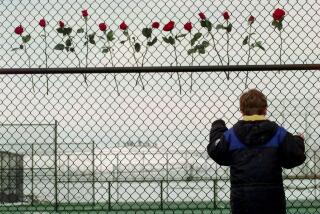School Massacre Not Worst; Ask the People of Bath, Mich.
- Share via
Several American newspapers and television networks called this week’s mass killing in Littleton, Colo., “the worst U.S. school massacre.” The people of Bath, Mich., a small farming town just outside Lansing, know differently.
On the sun-drenched morning of May 18, 1927, 45 people--including 38 children--where killed when an embittered school board official set off a series of bombs inside the town’s three-story brick schoolhouse. That horrific attack has been called the bloodiest ever on a U.S. school campus.
The bombing was front-page news in the heady, carefree days of the Roaring ‘20s but has long since slipped from the national memory.
Andrew Kehoe, a 55-year-old farmer and treasurer of the Bath school board, was upset that the new Bath Consolidated School had been funded by a tax increase. The new tax threatened his farm with foreclosure, according to Wednesday’s Detroit News.
Most of the dead were children ranging in age from 6 to 8. An Associated Press dispatch of the day reported that Kehoe wired the basement with “more than 500 pounds of dynamite scattered in various places.”
Kehoe set off dynamite, “burying the teachers and pupils under tons of debris,” Associated Press wrote. Principal E.E. Huyck rushed to confront Kehoe, who was attaching another wire to more explosives inside his car. As the two men “grappled,” the bomber fired a rifle into his car, setting off the explosives there.
Both Kehoe and Principal Huyck were killed. Before setting off the blasts at the schoolhouse, Kehoe had killed “his wife and horses,” AP reported, and blown up his home.
Like their contemporaries, the reporters of the day interviewed Kehoe’s neighbors in an attempt to understand what could have prompted a seemingly ordinary man to commit such a crime. “His neighbors considered him a good farmer, for his lands were well kept and his buildings well furnished. . . . He had appeared intelligent, but with a tendency toward being pugnacious.” The controversy with the school board, it was reported, had left him “morose.”
A few years back, according to the Detroit News, a state historic marker was erected in the park that now occupies the former site of the school. The marker lists the names of the children.
More to Read
Sign up for Essential California
The most important California stories and recommendations in your inbox every morning.
You may occasionally receive promotional content from the Los Angeles Times.













